Economic Importance, Harmful Effects & Types of Bacteria | Additional Study Material for NEET PDF Download
| Table of contents |

|
| Economic Importance of Bacteria |

|
| Some Important Points |

|
| Actinomycetes - Filamentous Bacteria |

|
| Cyanobacteria - Blue Green Algae (B.G.A) |

|
Economic Importance of Bacteria
➢ Harmful Activities
(i) Disease in Human Beings
(ii) Disease in Animals
(iii) Disease in Plants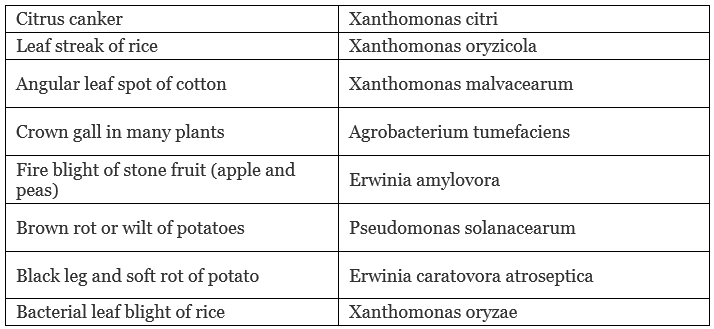
(iv) Denitrification - Denitrifying Bacteria
- Some bacteria convert soil nitrates into nitrites and then nitrogen.
- These bacteria reduce the fertility of the soil.
Denitrifying Bacteria
(v) Food Poisoning: Some bacteria are responsible for food poisoning.
These are of three types:
- Salmonella enteritidis: These bacteria survive on milk products and also in intestine of man. They secrete toxins. Symptoms - Vomiting, Dysentery.
- Staphylococcus aureus: These bacteria survive on milk and egg products. They secrete toxins which damage the central nervous system. These toxins are heat resistant.
- Botulism - Clostridium botulinum: It is most lethal type of food poisoning. These bacteria survive in absence of O2. These bacteria grow in canned food. Their toxins damage the parasympathetic nervous system. It leads to paralysis of both smooth and striped muscles, resulting in immediate death.
Table: Main Food Poisoning Bacteria
(vi) Water pollution: Several bacterial forms cause water pollution. These bacteria spoil the water.
Example: Vibrio cholerae, Salmonella typhi, Shigella dysenteriae.
(vii) Biological Weapons: Some bacteria are used as bioweapons such as Anthrax causing, Botulism and Cholera causing bacteria.
➢ Useful Activities
1. Ammonification - Ammonifying bacteria: Some bacteria convert Protein (present in decaying plants & animals) into Ammonia.
Example: Bacillus vulgaris, Bacillus mycoides, Bacillus ramosus.
2. Nitrification- Nitrifying bacteria: These bacteria convert Ammonia into Nitrite and later into Nitrate.
3. Nitrogen fixation - Nitrogen fixing bacteria: These bacteria convert the atmospheric nitrogen into nitrogenous compounds like amino acids, nitrate or ammonium salts.
Nitrogen fixation is done by two methods.
- Symbiotically: Some bacteria live symbiotically in the root nodules of some plants and do nitrogen fixation.
- Rhizobium: In the root nodules of legumes such as alfalfa, sweet clover, sweet pea, lentils, garden pea, broad bean, clover beans.
- Aerorhizobium: In the stem nodules of Sesbania.
- Azospirillum: Found on root surface of cereals i.e. superficial symbiosis (eg. Wheat, Rice, Maize).
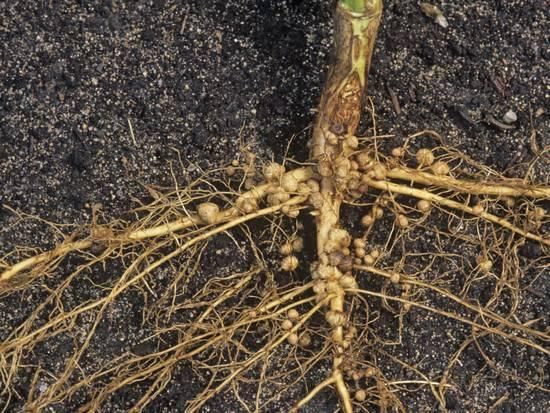 Nitrogen Fixing Bacteria (Rhizobium)
Nitrogen Fixing Bacteria (Rhizobium)
- Frankia: In root nodules of non-leguminous plant Casurina and Alnus plants.
- Asymbiotically: Some bacteria occur free in soil and do nitrogen fixation. Example: Clostridium, Chromatium, Azotobacter, Azospirillum, Beijernickia Rhodomicrobium, Rhodospirillum, Rhodopseudomonas.
Note: Azotobacter and Beijernickia are aerobic Rhodospirillum is anaerobic bacteria. Both Rhizobium and Frankia are free-living in soil, but as symbionts, can fix atmospheric nitrogen.
4. Dairy products: Dairy products are formed with the help of bacterial fermentation.
Curd – It is made by milk.

Note: Lactobacillus lacti (LAB/Lactic acid bacteria) increases vitamin B12 in curd LAB also help in checking the disease-causing microbes in the stomach.
5. Antibiotics
- Term antibiotic was given by S.A. Waksman.
- First discovered antibiotic was Penicillin it was obtained from fungi Penicillium.
 Antibiotics
Antibiotics
- First discovered antibiotic from bacteria was streptomycin.
- Many antibiotic medicines are obtained from the bacteria.
- Some substances produced by microorganisms which inhibit the growth of other micro-organism are called antibiotic substances.
- These antibiotic medicine cure the disease through the competitive inhibition.
Table: Bacteria and Antibiotics
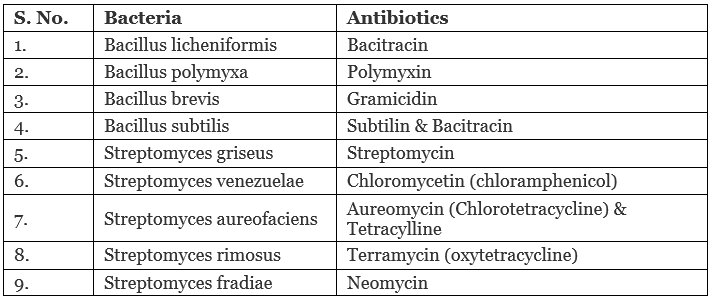
6. Industries
- Alcohol formation: Ethanol is formed with the help of yeast (fungi) or bacteria (Sarcina veutriculi) by the process of fermentation.

- Vinegar formation (Acetic acid )
- Retting of fibres: Clostridium, Butyric acid bacteria.
- Flavouring of tea and tobacco leaves: Bacillus megatherium, Micrococcus condiscence.
- Cleaning of hides: Any saprotrophyte.
- Production of Vitamins: lostridium butylicum produces → Riboflavin (Vit. B2).
- Propionibacterium and Bacillus megatherium produce Vit. B12
- E.coli produces → Vit. E., Vit. K. (E. coli bacteria found in the alimentary canal of human beings).
- Butyric acid formation

7. Decomposing bacteria: Some bacteria decompose the harmful chemicals.

8. Bacteria for specific pests: Bacteria are used to kill specific pests.
Example: Bacillus popillinae– Japanese Beetle, Bacillus sphaericus– Anopheles.
9. Purity of Ganga water: In Gangetic water a bacteria Bdellovibrio bacterovorus is found, they kill the other water polluting bacteria.
10. Pollution indicating bacteria: Polluted waters can be identified by the presence of E. coli. Quality of water depends on number of E. coli. So the E. coli is known as pollution indicating bacteria.
 E. Coli bacteria
E. Coli bacteria
11. Oil Clearing bacteria: Pseudomonas putida.
12. Bacteria for genetic engineering: E. coli and Agrobacterium.
Some Important Points
- Mycolic acid: Present in all filamentous bacteria.
- Bacteroids: Symbiotic bacteria which are present in root nodules of plants are known as bacteroids.
- Pus bacteria Staphylococcus (produces yellow pus).
- Pseudomonas (Produces blue pus) .
- nif gene: "Nitrogenase Inducing factor".
- nif gene is present in all nitrogen-fixing bacteia.
- Bacillus thuringiensis: This bacterium is related with ‘‘Bt’’ toxin.
Actinomycetes - Filamentous Bacteria
- They were previously included in Fungi and were known as Ray fungi, because structurally they are similar to fungi.
- The body of fungi is known as mycelium and the structure of actinomycetes is also similar to mycelium. Therefore they were included in fungi. But fungi are eukaryotic while actinomycetes are prokaryotic. So these are now placed in kingdom Monera.
- Now their new name is Mycobacteria, Mycelial bacteria or Filamentous bacteria.
- Filamentous bacteria are found more in soil.
- These bacteria have economic importance because they are used to prepare many antibiotics.
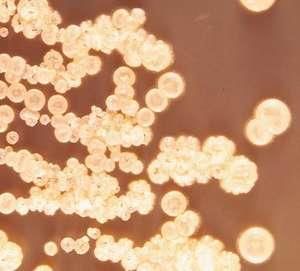 Actinomycetes
Actinomycetes
➢ Conidia
- Filamentous bacteria reproduce by means of conidia.
- Conidia are spore-like structures and are formed in basipetal manner in chains at the apex of conidiophores.
- Each condium gives rise to a new bacterium.
- These conidia are called as arthrospores due to their prokaryotic nature. Example: Streptomyces, Mycobacterium, Beggiatoa, Frankia
Cyanobacteria - Blue Green Algae (B.G.A)
- According to Two-kingdom system B.G.A. were included in class Cyanophyceae or Myxophyceae of Algae. But now they are included in Kingdom Monera, because of their prokaryotic nature.
- B.G.A. is now known as cyanobacteria.
Cyanobacteria: Blue-Green Algae
- The name cyanobacteria was suggested by ICNB [ International Code of Nomenclature for Bacteria] in 1978.
- Cyanobacteria are photosynthetic prokaryotes. Some eubacteria are also photosynthetic but there is some differences in the photosynthesis of cyanobacteria and eubacteria.
- Cyanobacteria were the first organisms that produced O2 on our earth.
Table: Difference between Cyanobacteria and Eubacteria

Note: Cyanobacteria are not always of blue-green colour.
Example: Trichodesmium is a red coloured. The red colour of water of red sea is due to this algae.
➢
Different Forms of B.G.A. or Cyanobacteria
- Unicellular: Some B.G.A. are unicellular.
Example: Spirulina
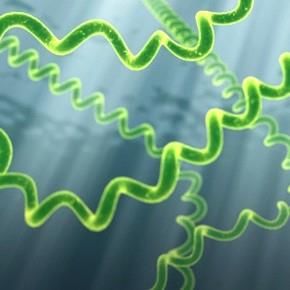 Spirulina
Spirulina
- Colonial: Some B.G.A. are found in colony. i.e. cell colonies.
Example: Anabaena, Microcystis - Filamentous: Some B.G.A. are filamentous. There are many cells arranged in a row in their body. The filament of B.G.A. is known as trichome.
Example: Oscillatoria
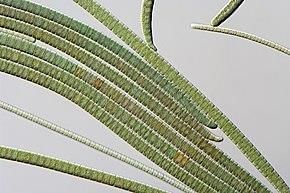 Oscillatoria
Oscillatoria
Note: Spirulina is an edible B.G.A. because it has very large amount of proteins. It can be grown artificially in water tanks. It is used as a fodder for cattle.
➢
Structure of B.G.A.
- The structure of B.G.A. is similar to Gram (-ve) eubacteria.
- B.G.A. is surrounded by a mucilaginous sheath. This sheath is made up of mucopolysaccharides [Pectic acid]. The cell wall of B.G.A. is also bilayered. The outer wall is made up of lipopolysaccharides and the inner wall is made up of peptidoglycan.
- The cell membrane of B.G.A. is also made up of lipoproteins like that of eubacteria.
The cytoplasm of B.G.A. is divided into two parts:
(i) Peripheral cytoplasm: It is known as chromoplasm. In this part, gas vacuoles and photosynthetic thylakoids are found. Photosynthetic pigments are present on the surface of these thylakoids.
(ii) Central cytoplasm: This is known as centroplasm. In this region, nucleoid is present. Ribosomes are of 70s type, and are scattered in both chromoplasm and centroplasm. Cyanobacterial cell
Cyanobacterial cell
Note:
1. The cytoplasm of prokaryotes lacks membrane-bound cell organelles but exceptionally in B.G.A. two membrane-bound structure are present.
(i) Gas vacuole: It provides the buoyancy to the B.G. algae in water.
(ii) Thylakoids: Photosynthetic pigments are present on its surface.
2. Exceptionally gas vacuoles are also present in purple and green photosynthetic bacteria.
➢
Stored Food
B.G.A. stores its food in the form of α-granules and β-granules.
- α- granules: They are made up of cyanophycean starch. It is structurally similar to glycogen.
- β-granules: They are made up of fat droplets.
➢
Nitrogen Fixation
- Most of the B.G.A., can perform Nitrogen fixation. They convert atmospheric nitrogen into nitrogenous compounds like amino acids, nitrates.
- These nitrates increase the fertility of soil.
- Oscillatoria can survive in hot water springs. The temperature of this water is about 80°C. Oscillatoria have capacity to tolerate high temperature because of homopolar bonds in proteins.
- Homopolar bonds in proteins - Proteins are denatured at high temperature and the living beings die. But homopolar bonds are present in the proteins of cytoplasm of Oscillatoria, which can not break easily and the bonds are in large number so they can tolerate high temperature.
- Hence B.G.A. improves the fertility of soil by nitrogen fixation under anaerobic conditions occurs mainly in large, specialized cells called heterocysts.
- Thickened cell wall of these cells is impermeable to oxygen so this creates anaerobic environment in the cell even under aerobic conditions.
- Besides this, heterocysts also lack PS-II activities and CO2 fixation is done only by vegetative cells. Oxygen is not evolved due to absence of PS-lI.
- However, PS-I remains active in heterocyst which generates ATP required to fix nitrogen.
- Besides N2 fixation heterocyst promotes fragmentation.
Important Points
- A special type of cell is found for nitrogen fixation in BGA which is known as heterocyst. Heterocysts are thick walled, non-green cell.
- Heterocysts don't perform the photosynthesis like other vegetative cells.
- Nitrogenase enzyme is necessary for nitrogen fixation. For the synthesis of this enzyme, there is a special type of gene present in BGA, which is known as nif-gene [nif = nitrogenase inducing factor]. This gene stimulates the production of nitrogenase enzyme.
- The discovery of nitrogen fixation in BGA was done by an Indian scientist - P.K. De
- Detailed study of N2 - fixation - Prof. R.N. Singh (Indian).
➢ Reproduction
In BGA reproduction is done by two main processes:
1. Vegetative Reproduction
- Binary fission: This is the most common method of reproduction in prokaryotes. By this process only unicellular prokaryotes can reproduce.
Example: Spirulina - Fragmentation: Filamentous prokaryotes, reproduce by this process. At the time of reproduction, some cells become thick walled, which are known as harmocyst (hormogonia). Due to the formation of hormogania, the filament is broken and each part grows into a new filament.
Example: Oscillatoria, Nostoc, Anabaena.
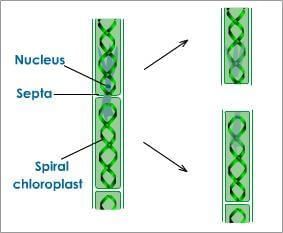 Fragmentation in Spirogyra2. Asexual Reproduction
Fragmentation in Spirogyra2. Asexual Reproduction
It is method of protection from unfavourable conditions.
- Water Bloom: Excessive growth of plants in water, that pollute the water.
- It mainly develops due to BGA eg. Anabaena flos-aquae, Microcystis aeruginosa, Aphanizomenon flos-aquae.
- BGA grow rapidly in water and secrete toxic substances. These toxic substances are known as death factor.
- Death factor is the main cause of death in aquatic animals. It also gives toxicity and bad odour to the water.
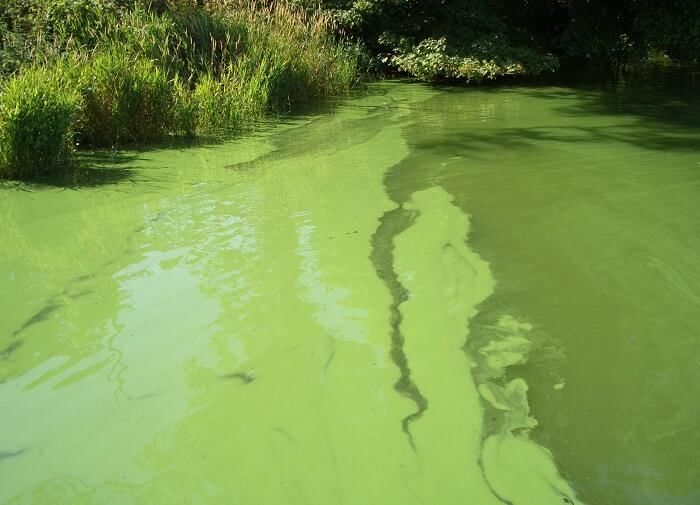 Water bloom
Water bloom
Note: In B.G.A. genetic recombination was first discovered by H.D. Kumar.
➢
Economic Importance of B.G.A.
- They provide fertility to soil by nitrogen fixation.
Example: Nostoc, Anabaena - The most proteinaceous food for animals.
Example: Spirulina - It gives fertility to sterile alkaline soil and usar soil. BGA secretes an acidic chemical which decreases the alkalinity of soil.
Example: Nostoc comune, Scytonema ocellatum, Aulosira fertilissima. - Some BGA are used as green manure
Example: Anabaena, Spirulina - Some BGA secrete toxin, which inhibits the growth of mosquito larva in water Example: Oscillatoria, Anabaena, Aulosira
- They are the most ancient organisms having oxygenic photosynthesis and thus played significant role in the evolution of aerobic forms of life.
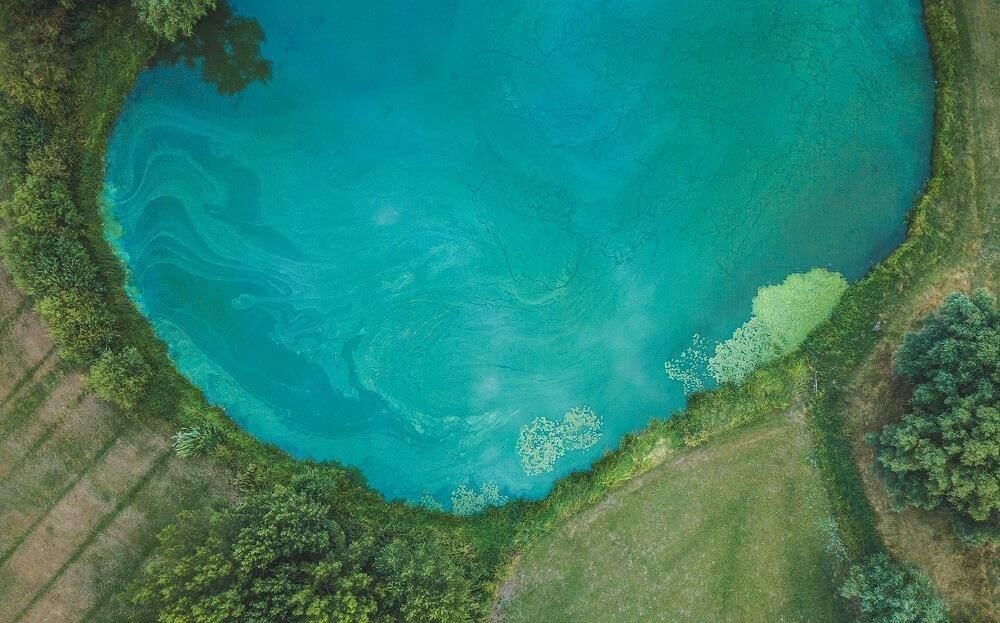 Blue green algae
Blue green algae
➢
Harmful Activities
- Excessive growth of blue green algae in water bodies is known as water bloom.
- The layer of B.G.A. formed on water bodies prevents the sunlight and oxygen to reach to the marine organisms thereby leading to their death.
- The excess growth is caused due to increased concentration of nutrients in water bodies. Usually the nutrients from the fields are flow to these waters during rain making the water bodies suitable for the growth of blue green algae.
|
26 videos|312 docs|64 tests
|
FAQs on Economic Importance, Harmful Effects & Types of Bacteria - Additional Study Material for NEET
| 1. What is the economic importance of Actinomycetes? |  |
| 2. How are Cyanobacteria economically important? |  |
| 3. What are the harmful effects of bacteria? |  |
| 4. What are the different types of bacteria? |  |
| 5. How do bacteria contribute to the nutrient cycle? |  |
















